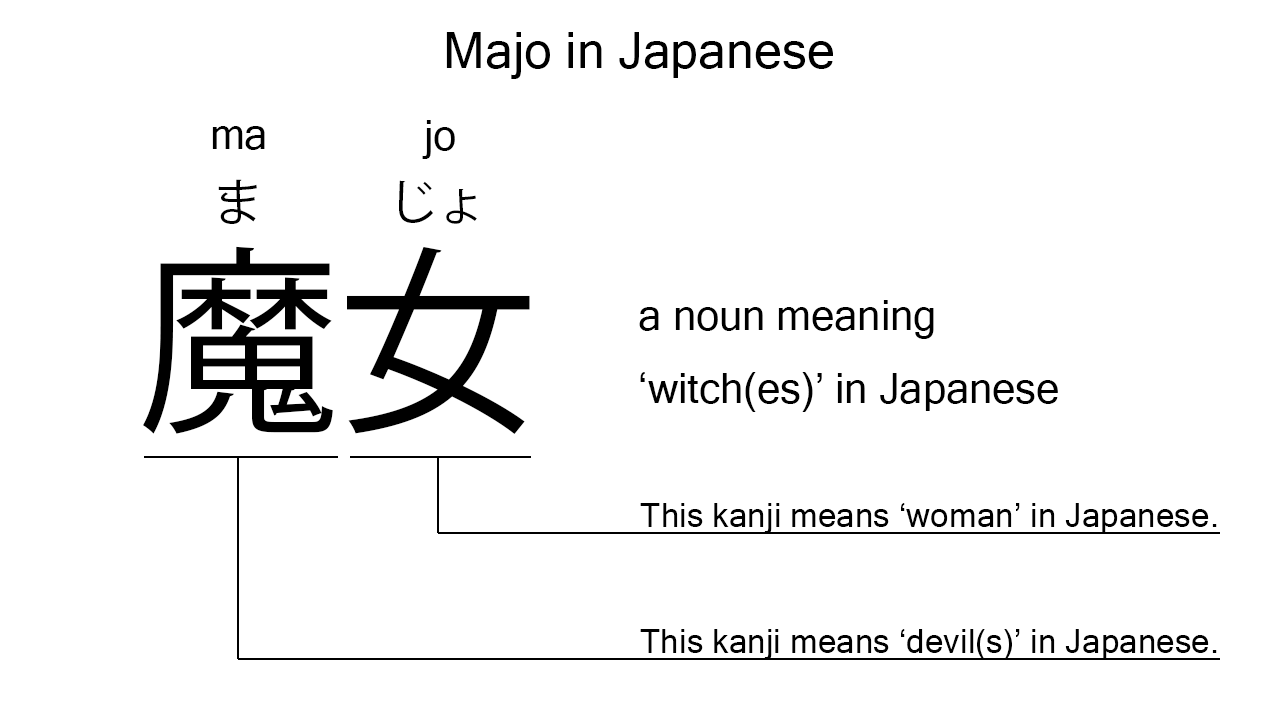What does “majo” mean in Japanese?
Native speakers say “majo” to mean ‘witch’ in Japanese. Perhaps, some Japanese learners know this word as it is sometimes used in Japanese movies, songs, novels, manga, anime, and the like. In this blog post, however, I will explain this word in detail based on its kanji expression. And also, I will explain how to use it through example sentences. My explanations would help Japanese learners understand “majo” more clearly. Then, let’s get started!
Contents
Definition and meaning of “majo”
Let me start with the definition and meaning of “majo”.
- majo – 魔女 (まじょ) : a noun meaning ‘witch’ in Japanese. This can also work as plural. Learn more about Japanese plural.
Japanese native speakers use this noun normally to refer to women who can cast magic spells. It’s also worth mentioning here that they sometimes use this noun to refer to women who look much younger than they are.
The definition and meaning are simple and clear. To understand this noun more clearly, however, let me explain its kanji characters in detail, one by one.
What does “majo” literally mean in Japanese?
The kanji expression of “majo” consists of the following two kanji characters:
- 魔 : a kanji character used to mean ‘devil’, ‘demon’, or ‘something supernatural’ in Japanese.
- 女 : a kanji character used to mean ‘woman’ in Japanese.
These two kanji characters tell us that “majo” literally means a ‘devil woman’ in Japanese. This literal interpretation is not in line with the actual meaning, but still understandable, I think. Witches are often women who have magic powers like devils.

When we meet new kanji expressions, we should check their kanji characters in detail to understand their meanings clearly and deeply. In many cases, kanji characters tell us a lot about the meanings of the expressions they form. Actually, here, we could get the better understanding of “majo” through the detailed kanji check above.
So far, I’ve explained the definition and meaning of “majo” together with its kanji characters. Then, let me explain how to use it through the example sentences below.
Example #1: how to say “witch” in Japanese
kanojo wa wakai majo desu – 彼女は若い魔女です (かのじょはわかいまじょです)
She is a young witch.
Below are the new words used in the example sentence.
- kanojo – 彼女 (かのじょ) : a pronoun meaning ‘she’ in Japanese.
- wa – は : a binding particle working as a case marker or topic marker. In the example, this works after “kanojo” to make the subject in the sentence.
- wakai – 若い (わかい) : an i-adjective meaning ‘young’ in Japanese. In the example, this works as a modifier in front of “majo”.
- desu – です : an auxiliary verb used after a noun or adjective to make it polite. Probably, this is well known as a part of Japanese desu form. In the example, this is used after the noun phrase, “wakai majo”, to make it sound polite.
This is a typical usage of “majo”. In the example, it works together with the i-adjective, “wakai”, to mean a ‘young witch’ in Japanese.
Example #2: another usage of “majo”
「majo wa kowaku nai」 to kanojo ga it ta – 「魔女は怖くない」と彼女が言った (「まじょはこわくない」とかのじょがいった)
“Witches are not scary,” she said.
Below are the new words used in the example sentence.
- kowaku – 怖く (こわく) : one conjugation of the i-adjective, “kowai“, which means ‘scary’ in Japanese. In the example, it has been conjugated for the better connection with its following word.
- nai – ない : an auxiliary verb used after a verb, adjective, or auxiliary verb to deny its meaning. In the example, this is used after “kowaku” to deny its meaning. Word orders in Japanese and English are different, but the role of this auxiliary verb is similar to that of “not”.
- to – と : a case particle working as a quote marker. In the example, this works after the clause to indicate what she said.
- ga – が : a case particle used to make the subject word or the object word in a sentence. In the example, this is used after “kanojo” to make the subject in the sentence.
- it – 言っ (いっ) : one conjugation of the verb, “iu“, which means ‘to say’ in Japanese. In the example, it has been conjugated for the better connection with its following word.
- ta – た : an auxiliary verb used after a verb, adjective, or auxiliary verb to make its past tense form. In the example, this is used after “it” to make its past tense form, “it ta”.
This is another typical usage of “majo”. In this example, it works together with the binding particle, “wa”, to become the subject in the clause. When we want to mean a ‘witch’ or ‘witches’ in Japanese, anyway, this noun is always a very good option.
Summary
In this blog post, I’ve explained the definition and meaning of “majo” in detail based on its kanji expression. And also, I’ve explained how to use it through the example sentences. Let me summarize them as follows.
- majo – 魔女 (まじょ) : a noun meaning ‘witch’ in Japanese. This can also work as plural. These two kanji characters literally mean a ‘devil woman’ in Japanese. This literal interpretation is not in line with the actual meaning, but still understandable, I think. Witches are often women who have magic powers like devils. It’s also worth mentioning here that Japanese native speakers sometimes use this noun to refer to women who look much younger than they are.
Hope my explanations are understandable and helpful for Japanese learners.
Leave a Reply